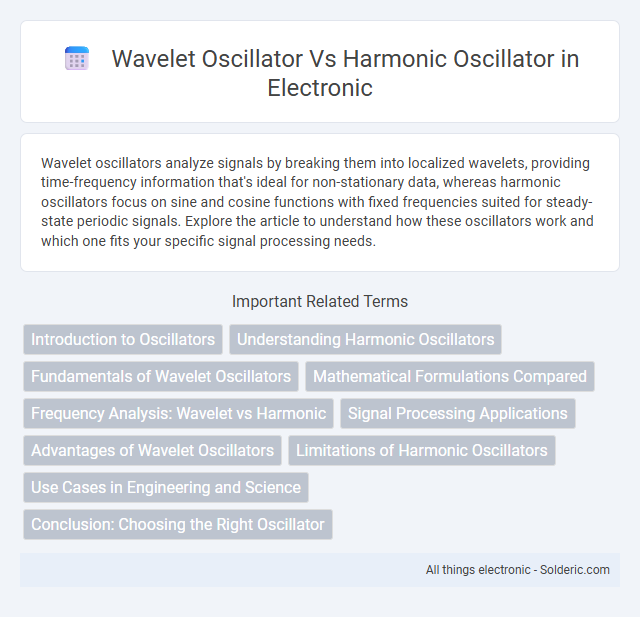Wavelet oscillators analyze signals by breaking them into localized wavelets, providing time-frequency information that's ideal for non-stationary data, whereas harmonic oscillators focus on sine and cosine functions with fixed frequencies suited for steady-state periodic signals. Explore the article to understand how these oscillators work and which one fits your specific signal processing needs.
Comparison Table
| Feature | Wavelet Oscillator | Harmonic Oscillator |
|---|---|---|
| Definition | Oscillator using localized wavelet functions for transient analysis | Oscillator with fixed frequency sine and cosine components |
| Frequency Characteristics | Multi-resolution, frequency varies over time | Single, constant frequency |
| Time-Frequency Localization | High, suitable for non-stationary signals | Low, ideal for stationary signals |
| Applications | Signal processing, time-frequency analysis, transient event detection | Mechanical vibrations, electrical circuits, simple harmonic systems |
| Mathematical Basis | Wavelet transform and wavelet bases | Second-order differential equations, sinusoidal functions |
| Signal Analysis | Captures time-localized features and abrupt changes | Focuses on steady oscillations and periodicity |
Introduction to Oscillators
Oscillators generate repetitive signals, crucial in diverse fields like physics and engineering. Wavelet oscillators provide localized time-frequency analysis, making them ideal for non-stationary signal processing. Harmonic oscillators, characterized by sinusoidal waveforms and constant frequency, model simple periodic systems such as pendulums or LC circuits, offering a fundamental understanding of oscillatory behavior for your applications.
Understanding Harmonic Oscillators
Harmonic oscillators, characterized by sinusoidal motion with a constant frequency and amplitude, serve as fundamental models in classical mechanics and signal processing. Unlike wavelet oscillators, which analyze signals with varying frequency and time localization, harmonic oscillators maintain steady-state oscillations described by solutions to the simple harmonic motion differential equation. Their predictable behavior enables precise modeling of systems such as springs, pendulums, and electrical circuits.
Fundamentals of Wavelet Oscillators
Wavelet oscillators utilize wavelet transforms to analyze signals with varying frequency components over time, providing better time-frequency localization compared to traditional harmonic oscillators that rely on fixed-frequency sine and cosine functions. These oscillators decompose signals into scaled and shifted versions of a mother wavelet, capturing transient features and non-stationary data effectively. Your signal processing applications benefit from wavelet oscillators through enhanced detection of localized frequency anomalies and improved analysis of complex, dynamic signals.
Mathematical Formulations Compared
The wavelet oscillator uses wavelet transforms to analyze signals across multiple scales, providing time-frequency localization through dilations and translations of a mother wavelet function ps(t), defined as W(a,b) = x(t) ps*((t - b)/a) dt / a. In contrast, the harmonic oscillator is modeled by the second-order differential equation d2x/dt2 + o2x = 0, representing sinusoidal motion with a fixed angular frequency o, characterized by solutions x(t) = A cos(ot) + B sin(ot). While the harmonic oscillator captures periodic and steady-state behavior through simple sine and cosine functions, the wavelet oscillator captures transient and non-stationary signals by decomposing them into scaled and shifted wavelet bases.
Frequency Analysis: Wavelet vs Harmonic
Wavelet oscillators offer time-frequency analysis by decomposing signals into localized wavelets, enabling detection of transient and non-stationary frequency components with high resolution. Harmonic oscillators analyze signals based on fixed, infinite-duration sine and cosine waves, providing precise frequency identification but limited time localization. Wavelet analysis excels in capturing dynamic frequency variations, while harmonic oscillators are optimal for steady-state frequency decomposition.
Signal Processing Applications
Wavelet oscillators excel in signal processing applications by providing localized time-frequency analysis, enabling precise detection of transient and non-stationary features in signals. Harmonic oscillators, characterized by fixed frequency components, are ideal for analyzing periodic or steady-state signals but lack the adaptability to capture evolving signal dynamics. Your choice depends on whether the application demands detailed temporal resolution or stable frequency analysis for optimal signal interpretation.
Advantages of Wavelet Oscillators
Wavelet oscillators provide superior time-frequency localization, allowing more precise analysis of non-stationary signals compared to harmonic oscillators that rely on fixed frequency components. These oscillators enable multiresolution analysis, capturing transient features and abrupt changes in signals with high accuracy. Their adaptability to various signal scales enhances performance in applications such as signal processing, communications, and biomedical engineering.
Limitations of Harmonic Oscillators
Harmonic oscillators are limited by their inability to analyze non-stationary signals effectively, as they assume constant frequency and amplitude over time. Your data may suffer from poor time-frequency localization when using harmonic oscillators, which hinders accurate transient or abrupt event detection. Wavelet oscillators overcome these constraints by providing multi-resolution analysis, adapting to both time and frequency variations for better signal characterization.
Use Cases in Engineering and Science
Wavelet oscillators excel in analyzing non-stationary signals in engineering applications such as vibration monitoring and fault detection due to their time-frequency localization capabilities. Harmonic oscillators are fundamental in modeling periodic phenomena in physics and electrical engineering, including mechanical vibrations and AC circuit behavior. The choice between wavelet and harmonic oscillators depends on whether the system requires adaptive time-scale analysis or a steady-state sinusoidal representation.
Conclusion: Choosing the Right Oscillator
Selecting the ideal oscillator depends on the application's complexity and signal characteristics; wavelet oscillators excel in analyzing non-stationary signals with multi-resolution capabilities while harmonic oscillators perform best with stable, periodic phenomena. Wavelet oscillators provide superior time-frequency localization, crucial for transient signal processing, whereas harmonic oscillators are simpler and efficient for modeling constant frequency oscillations. Understanding the trade-offs in adaptability and computational complexity helps optimize performance in fields like signal processing, communications, and physics.
Wavelet oscillator vs Harmonic oscillator Infographic

 solderic.com
solderic.com